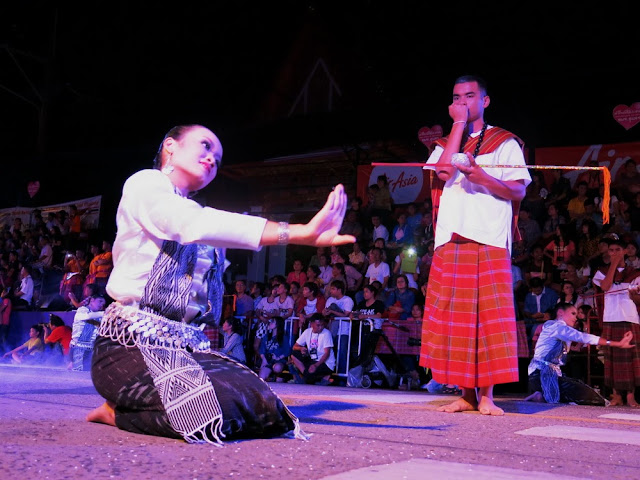The province’s annual Candle Festival started in 1977, though the smaller scale Lent candle processions existed long before that.
Thung Si Mueng, or the city’s plaza, is where most of the action is likely to take place. This areagets very busy as almost 500 street stalls claim their space even though the processions themselves aren’t carried out until a few days later – one on Asanha Bucha night, and the other on the following morning which is the beginning of the Buddhist Lent.
It is almost 5 o’clock in the evening of Asanha Bucha when some of the candle and wax sculpture floats are marched to Thung Si Mueng. We weave our way through the crowd waiting excitedly for those floats to arrive. Everyone is here for the same reasons – to get a close-up look and snap shots of the floats that are the nominees of this year’s competition for best craftsmanship.
The competition involves 2 types of floats based on the method of decoration: wax carved sculptures, and those employing molded beeswax pieces. Each type is categorized according to the size of the floats - large, medium, and small. New to the competition this year, and much waited for, is the float of aromatic wax sculptures, the masterpiece by Dej Udom, the local community famous for its aromatic candle artistry.
Night falls, as does a drizzly rain , which is very common during Buddhist Lent, as it takes place during the rainy season. Despite the rain, stalls are busy with visitors and grandstands are quickly filled up by spectators guarding the best spots to watch the processionwhich is due to begin in a few hours.
The night procession is a short one, and opens with a performance of a light and sound show retelling the Ubon Ratchathani people’s way of life followedby last year’s champion wax and candle floats. The shows are impressive, and add excitement and context to the perfect glow of the spotlighted orange wax sculptures against the blacked-out sky.
But while the crowd enjoys the festivities, one group of people has to deal with a fairly heavy task. A notebook in hand, Atiwat Jantarawijit, one of the 10 float judges, circles around this carved float more than 3 times, looking, noting, and thinking hard. The job isn’t easy.
The sculptures must be in perfect proportion and symmetry. The designs, creativity, and details in the finished work all count. The judges can be architects, art professors, or candle sculptor specialists. "This is my 4th time being a judge and it’s still a difficult decision as to who is to win," said Atiwat.
On the next morning, the crowd gathers on the grandstands of Thung Si Muang’s main road again. This time, to witness the full-length version of the procession, which marks the official start of the Candle Festival. Heading the procession is the cart carrying the Lent candle bestowed to Ubon Ratchathani by His Majesty the King. And then, what will be a one-kilometer long procession begins. Each float is preceded by traditional performances, whether it is dances or the local mo lam bands, all of which represent Ubon Ratchathani’s core cultures and ways of life.
The sculptures themselves depict different Buddhist subjects, some are Buddha’s life and stories of his former incarnations , and others are morality tales. Si Pradu Temple’s float is probably the most eye-catching of all with its groups of sculptures picturing a scene from hell.
Moving at an extremely slow speed, the last float arrives at around 3 in the afternoon but it never lost its crowd of supporters despite the scorching sun or the rain.
On the following day, when the festivity dies down, the traffic around Thung Si Muang has eased as the roads reopen for vehicles, and the backwater atmosphere of Ubon Ratchathani’s downtown resumes; where all the nominated floats were exhibited, now only the winners remain.
Watch the story's video: http://www.youtube.com/watch?v=3Spn0B1NOMw
See more images of the story: http://www.flickr.com/photos/92886568@N08/sets/72157634661999550/
Send me comments: https://www.facebook.com/suwida.boonyatistarn.1











No comments:
Post a Comment